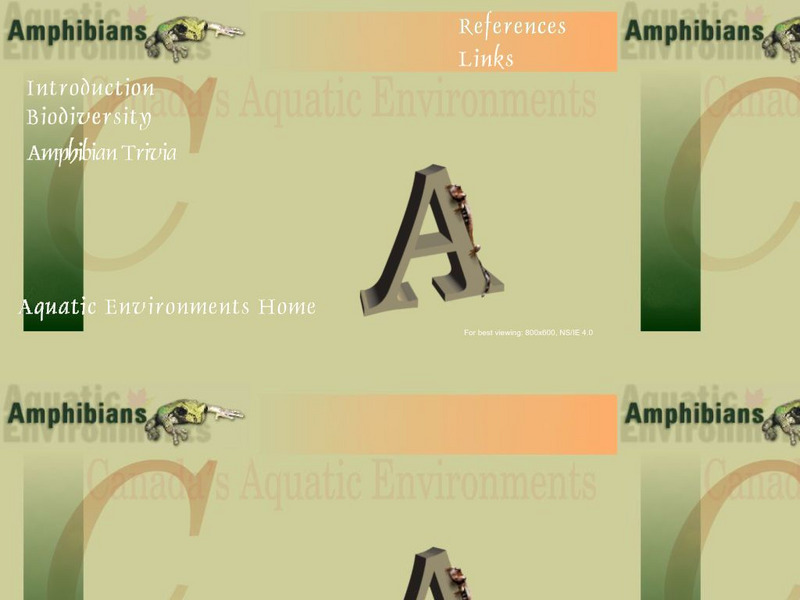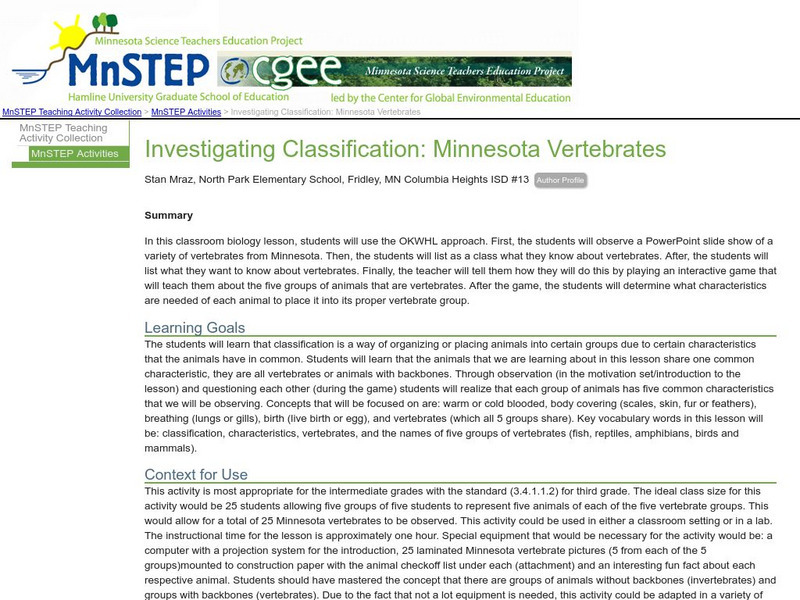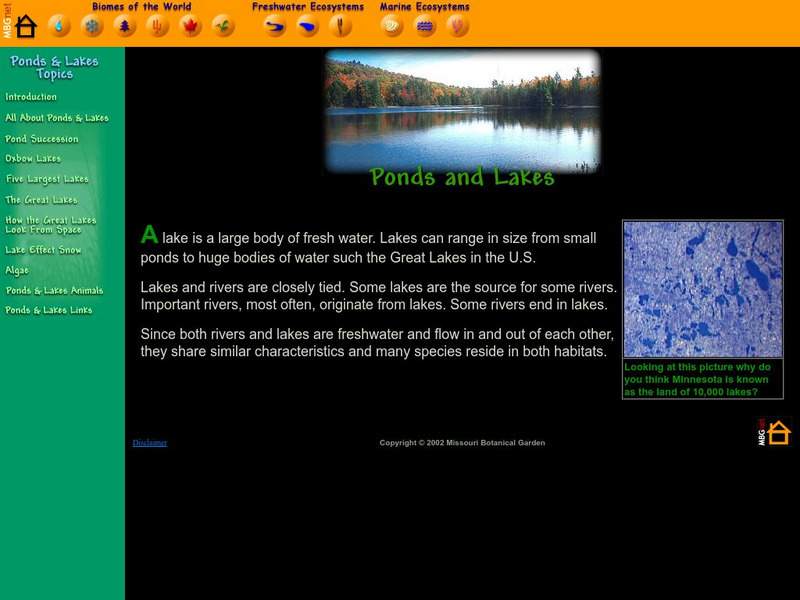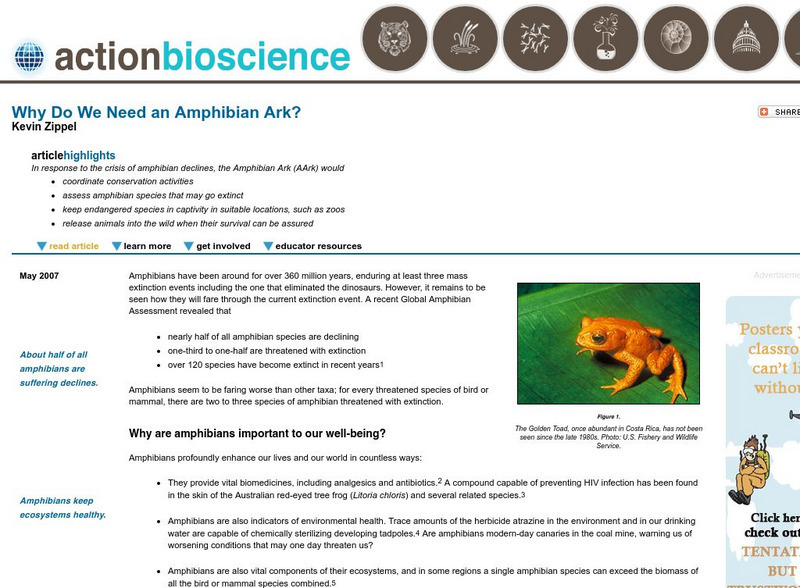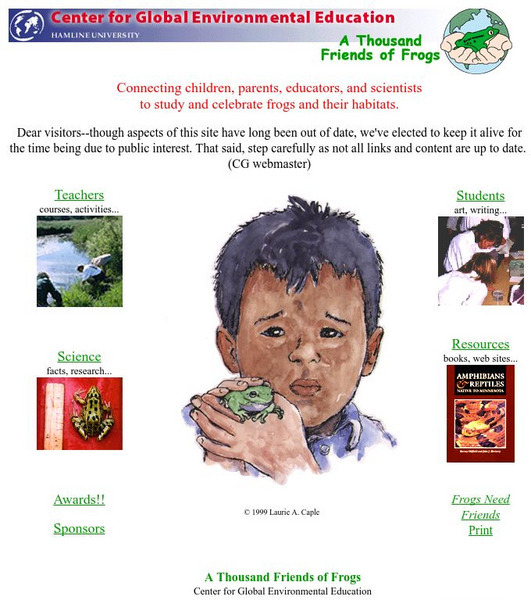Oakland Zoo
Oakland Zoo: Colorado River Toad
Meet the Colorado River Toad and discover fascinating facts and statistics. Learn about its physical characteristics, habitat, diet, behavior, breeding patterns, conservation, and more.
Oakland Zoo
Oakland Zoo: Golden Mantella Frog
Meet the golden mantella frog and discover fascinating facts and statistics. Learn about its physical characteristics, habitat, diet, behavior, breeding patterns, conservation, and more.
Exploratorium
Exploratorium: Frogs, a Disappearing Act
At this site students can read about how frogs camouflage to avoid predators. There is an interactive exhibit too! (Must have the Shockwave plug-in to see animation.)
Biology 4 kids
Biology4 Kids: Quiz: Amphibians
Take this ten-question review quiz over the Class Amphibia. Read more about each question after an incorrect answer is given.
University of Southern California
Structure of Matter: Animals
A slide show that demonstrates the development of physical structure in the animal world, moving from sponges through mammals.
University of Wisconsin
University of Wisconsin: Amphibian Embryology Tutorial
This amphibian embryology tutorial takes an in depth look at the question "Why study amphibians?". Through this tutorial students will develop a better understanding of vertebrate development.
PBS
Nh Pbs: Nature Works: Colorado River Toad
Come and check out this educational resource featuring the Colorado River Toad. The content of this site includes information on this species' characteristics, range, habitat, diet, reproduction, and behavior.
University of Guelph
Aquatic Environments: Amphibians
Offers a comprehensive guide to amphibians. Provides links to amphibian morphology, reproduction, ecology and evolution.
Science Education Resource Center at Carleton College
Serc: Investigating Classification: Minnesota Vertebrates
This lesson serves as an introduction to classification. The students will place animals into its proper vertebrate group according to certain characteristics that the animals have in common.
Missouri Botanical Garden
Missouri Botanical Garden: Freshwater Ecosystems
At this site from the Missouri Botanical Garden, you can learn about the wide variety of plant and animal life in or around fresh water ecosystems. Click on the links to "wetlands," "Ponds and Lakes," or "Rivers and Streams" to view...
Missouri Botanical Garden
Missouri Botanical Garden: Lakes and Ponds
This illustrated website features facts about lakes and ponds and their special place in geography, natural history, and as a biome.
American Institute of Biological Sciences
Action Bioscience: Why Do We Need an Amphibian Ark?
Amphibians have a challenge to rise above and are unable to succeed without the help of a vision like Amphibian Ark. This program is viewed to be a global effort to protect amphibians from extinction and promote the benefits these life...
PBS
Nh Pbs: Nature Works: California Tiger Salamander
This site created by NatureWorks focuses on the California Tiger Salamander. The content of this resource includes a look at this species' characteristics, range, habitat, food, reproduction, and behavior.
PBS
Pbs Teachers:costa Rica: Why So Many Frogs?
Explore the different stages in the growth of a frog, explain why organisms produce large numbers of young and determine the survival rate of a population of tadpoles under controlled conditions.
Pennsylvania State University
Penn State Altoona Biology: Circulatory System: Frog Dissection
This resource provides a look at the circulatory system of a frog in dissection.
Other
Center for Global Environmental Education: A Thousand Friends of Frogs
An in-depth site about the world of frogs. The site includes teacher, student, science, and research sections. There are plenty of facts and activities.
Other
K 3 Learning Pages: Reptiles and Amphibians
Come and discover more about reptiles and amphibians when you explore this awesome resource. This site is filled with useful links.
Other
Georgia Perimeter College: The Permian Period
This resource provides basic information of the changes that took place during the Permian period as well as the animals that populated the Earth during this time.
McGraw Hill
Glencoe Biology: Amphibians: Self Check Quiz
Try these five multiple-choice questions about amphibians. After submitting answers, students can review the material.
Other
Durrell Wildlife Conservation Trust: Rio Cauca Caecilian
Profile of one species of Caecilian, the Rio Cauca from Colombia and Venezuela.
Smithsonian Institution
Smithsonian National Zoo: Zoogoer Magazine: On Waterdogs, Mudpuppies, and More
Alex Hawes's article, "On Waterdogs, Mudpuppies, and the Occasional Hellbender" looks at the range of creatures within the classification of Amphibian. He does not spend time discussing frogs or toads in depth, but focuses on the rest of...
Smithsonian Institution
Smithsonian National Zoo: Zoogoer Magazine: The Mystery of Amphibian Declines
Howard Youth's article, "Chasing Frogs and Phantoms: The Mystery of Amphibian Declines" deals with the shrinking populations of amphibians and certain conservation efforts underway.
Animal Fact Guide
Animal Fact Guide: Spotted Salamander
Read interesting facts on the Spotted Salamander including information on its physical characteristics, habitat (with a distribution map), diet, breeding patterns, unique traits and behavior, conservation status, and tips on what you can...
San Diego Zoo Global
San Diego Zoo: Caecilian
Learn about an odd legless order of amphibian called Caecilians. This article details their habitat, physical characteristics, and methods of producing young.








